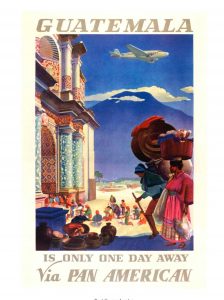 From its inception, PanAm capitalized on the past of Latin America to attract travelers. In its advertisements, PanAm continuously provided a historicized view of Latin America: towering ruins, indigenous families, and exotic landscapes that one could never find in the United States. They juxtaposed modernity—access by aeroplane—with antiquity. The aeroplane is “a metaphor for territorial unity”1 between the modern United States and the underdeveloped Latin American nations. It has the ability to unite an entire continent.
From its inception, PanAm capitalized on the past of Latin America to attract travelers. In its advertisements, PanAm continuously provided a historicized view of Latin America: towering ruins, indigenous families, and exotic landscapes that one could never find in the United States. They juxtaposed modernity—access by aeroplane—with antiquity. The aeroplane is “a metaphor for territorial unity”1 between the modern United States and the underdeveloped Latin American nations. It has the ability to unite an entire continent.
However, tourism is “an ethnography of modernity,”2 where nostalgia for the past attracts tourists through the creation of a heritage industry that offers “a celebration of past power relations and [projects] a vision of unalienated rationality.”3 Visiting Latin America’s Third World is seen as a return to simpler times, while still being able to return to the comfort of modernity after two weeks. As John Frow reflects, “the logic of tourism is that of a relentless extension of commodity relations and the consequent inequalities of power between center and periphery…Promising an explosion of modernity, it brings about structural underdevelopment, both because of its control by international capital and ‘because it is precisely the lack of development which makes an area attractive as a tourist goal.’ This is the paradox of the impossible appropriation of the Other repeated with an economic vengeance; and it is a paradox that rebounds, since any place at all can become the cultural Other of tourism.”4 By ascribing to the nostalgic demands of its tourist and heritage industry, Latin America seems to forever be positioned in a state of underdevelopment. Below are the PanAm posters that reflect, and influenced, this entire situation.
- Patricio del Real, “Building a Continent: MOMA’s Latin American Architecture since 1945 Exhibition,” Journal of Latin American Cultural Studies 16, no. 1 (2007): 98, doi:10.1080/13569320601156803.
- John Frow, “Tourism and the Semiotics of Nostalgia,” October 57 (1991): 129, doi:10.2307/778875.
- Ibid., pp. 134
- Ibid., pp.151